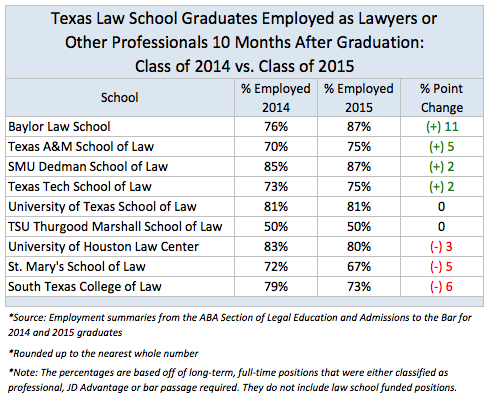© 2016 The Texas Lawbook.
By Natalie Posgate
(April 22) – Just a decade ago, earning a law degree was the sure fire way to a guaranteed job and a six-figure income. Not so much anymore.
Despite paying as much as $200,000 for their legal education, nearly one-fourth of the 2,072 Texas law school graduates of 2015 are unemployed or underemployed, according to new data compiled by The Texas Lawbook.

Statistics show that less than two-thirds of law school graduates in Texas from 2015 have full-time jobs as lawyers 10 months after graduating. About 12 percent of graduates are employed full-time in non-lawyer professional positions.
More than 13 percent of newly-minted Texas lawyers are unemployed, which is actually worse than the nine percent of 2010 Texas law school graduates who could not find a job after graduation – the year the Great Recession impacted the Texas legal industry the most.
Three percent of 2015 law graduates are stuck working part-time jobs – some of them having nothing to do with law at all, according to data just made public by the nine law schools in the state.
Independent legal industry analysts point to several factors, including low oil prices hurting the economy and drastic tort reform measures that limited or ended various kinds of litigation.
Large corporate law firms that only a few years ago hired 70 to 90 new law graduates annually are only adding 40 to 60 now.
Southern Methodist University’s Dedman School of Law and Baylor Law School fared the best in post-graduation employment, placing 87 percent of their most recent alumni in full-time, long-term lawyer positions or other professional jobs 10 months after graduation.
The University of Texas School of Law and the University of Houston Law Center successfully placed 81 percent and 80 percent, respectively, of graduates in the same positions.
Texas Southern University’s Thurgood Marshall School of Law and St. Mary’s School of Law have the worst record, only placing 50 percent and 67 percent, respectively, of their graduates in such positions.
All accredited law schools were required to submit their employment outcomes for 2015 graduates to the ABA in early April.
Overall, only 63 percent of the 2015 graduates have jobs as lawyers, which is a one percent increase from 2014.
Recent data indicates that the demand for legal services has remained flat since the end of the Great Recession.
The number of full-time practicing lawyers in Texas increased by less than 3,500 during the past four years – from 37,600 in 2012 to 41,000 now, according to the U.S. Bureau of Labor Statistics.
Yet, the nine Texas law schools – 10 once the University of North Texas College of Law graduates its first class next year – continue to pump out more than 2,000 new lawyers annually. This despite the fact that most law schools have shrunk their incoming classes over the past few years.
At the same time, the already-tight Texas legal market continues to pop buttons on the waistband due to the ongoing stream of out-of-state law firms opening offices in Texas.
“It took Texas longer to feel the recession in legal jobs than the rest of the nation,” said Faye Bracey, the assistant dean for career services at St. Mary’s University School of Law. “With the recent downturn in the oil and gas industry and the increase in attorneys who moved to Texas when the rest of the nation was experiencing high unemployment, the job market in Texas has become tighter.”

On the upside, BLS reports that the median annual salary for practicing lawyers in Texas is $137,000.
Compared to the 2014 ABA numbers, Texas law schools’ ability to place their 2015 graduates in these full-time, long-term positions as lawyers or other professionals is a mix of improvement and retrogression from the previous class.
Employment rates for these positions predominantly didn’t improve at all or got worse. UT and TSU placed the same amount of their 2015 graduates as they did in 2014 (81 percent and 50 percent, respectively).
South Texas College of Law dropped the most in securing these jobs for its graduates, from placing 79 percent of its 2014 graduates to 73 percent of its 2015 graduates. St. Mary’s School of Law dropped five percentage points and the University of Houston Law Center dropped three percentage points.
Though litigation has been South Texas’ “traditional” strength, Associate Dean for Academic Administration Bruce McGovern said an increasing amount of the law school’s graduates are going into transactional law.

Allison Hickey Regan, U of H’s assistant dean for career development, said the law school’s decline in job placement mirrors another trend: a national decline of bar exam passage rates.
Several law journals have reported that the applicant pool for law schools has shrunk, which in turn caused law schools to admit more students who don’t have hope to pass the bar. Larger business law firms only hire the best law students with the highest test scores.

St. Mary’s noticed a similar phenomenon.
“We have felt the effects of a national downward trend in the bar exam passage rate,” said St. Mary’s Law Dean Stephen M. Sheppard. “This has slowed the progress of some of our graduates to begin their careers. We are certain of their ultimate success, a datum not easily reflected in the report of employment made less than a year after graduation.”

The Waco-based school went from placing 76 percent of its 2014 graduates in permanent, full-time positions as lawyers or other professionals 10 months after graduation to placing 87 percent of its 2015 graduates in the same positions. The significant improvement caused Baylor and SMU Dedman School of Law to tie for No. 1 for job placement across the state.
Baylor was also the only law school to have zero unemployed graduates 10 months after graduation.
When examining job placements for lawyer-only positions (bar passage required), Baylor also fared the highest, placing nearly 82 percent of its 2015 graduates in such positions.
Angela Cruseturner, Baylor Law’s assistant dean of career development, listed multiple factors for the school’s improved employment rate.

“Since September 2012, we have met in person with over 400 employers, which provides us more relevant information about employers and the legal market that we pass on to students,” Cruseturner said in an email. “This shift in our office has also allowed us the space to devote significant time to individual counseling.”
She added that the law school has also implemented “innovative programs,” such as a three-year legal writing program and a mandatory professional development program.
“We have also encouraged and equipped students in their networking and relationship building skills, which they have utilized to position themselves to take advantage of new employment opportunities,” she added. “Credit the Class of 2015 for seizing the resources available and making the most of these enhanced opportunities resulting from a refined system and a brightening legal market.”
(Editor’s Note: The Texas Lawbook excluded law school funded positions from its analysis.)
© 2016 The Texas Lawbook. Content of The Texas Lawbook is controlled and protected by specific licensing agreements with our subscribers and under federal copyright laws. Any distribution of this content without the consent of The Texas Lawbook is prohibited.
If you see any inaccuracy in any article in The Texas Lawbook, please contact us. Our goal is content that is 100% true and accurate. Thank you.
